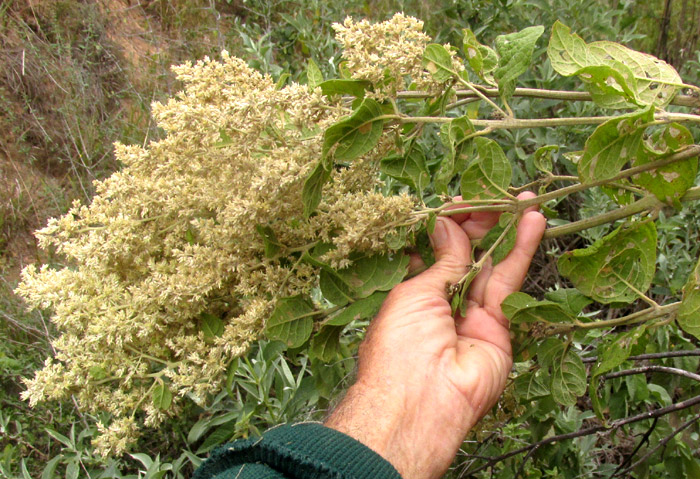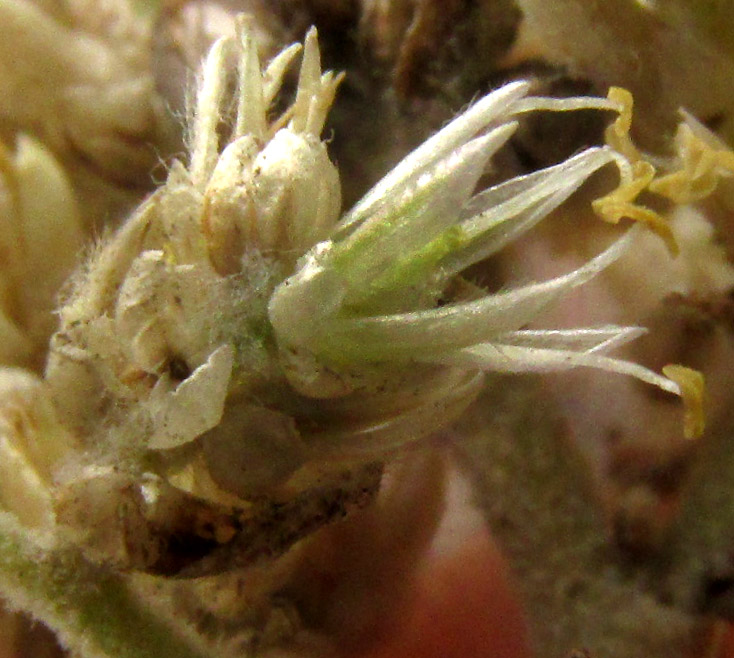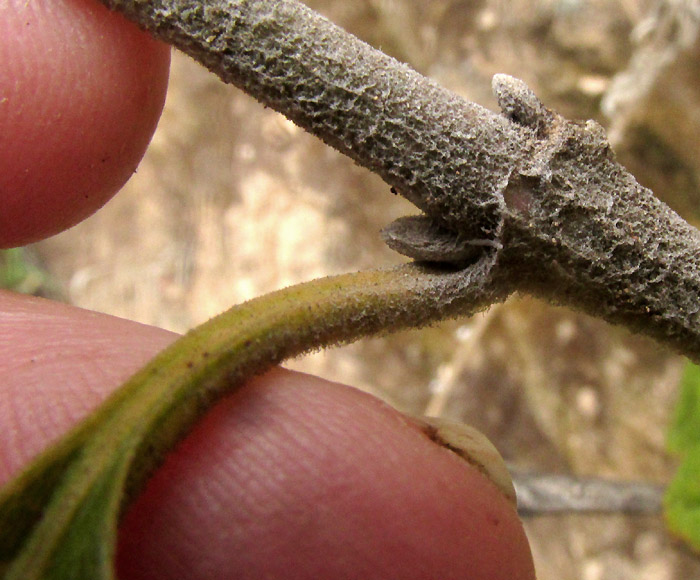Excerpts from Jim Conrad's
Naturalist Newsletter
Entry dated December 25, 2023, issued from near Tequisquiapan; elevation about 1,900m, (6200 ft), ~N20.57°, ~W99.89°; Querétaro state, MÉXICO
IRESINE CASSINIIFORMIS

The above woody shrub rooted in a crack in the wall of a weedy-bottomed, rarely flooded arroyo following an old fault line through irrigated fields of corn. The wall was composed of hard-compacted volcanic ash. If the shrub had stood erect, it would have been about 2.5m tall (8ft). The condition of the above plant should be considered in the context of our currently experiencing a continuing two-year drought described by the online North American Drought Monitor as a D3 Extreme Drought, after a rainy season that simply didn't develop.

With its dense plume of off-white flowers, even at a distance our shrub looked like a member of the Amaranth Family, the Amaranthaceae, a mostly tropical family of about 165 genera and over 2000 species. The small flowers, instead of developing calyxes and corollas, produce petal-like tepals which often are stiffly papery and whitish. Each of the numerous flowers is subtended by a scale-like bract and bracteoles of the same texture. The above inflorescence contains thousands of flowers and developing dry, utricle-type fruits. In botany, utricles are one-seeded fruits which have developed from a single ovary in a single flower, with their seeds surrounded by a bladder-like covering, the pericarp, derived from the flower's ovary wall.


Above and at the right you see a typical Amaranth Family flower. In this family, flowers can be either unisexual or bisexual. The above flower is a unisexual male one, and it arises from a compact cluster of several such male flowers. This species is dioecious, with distinct male and female trees. You can see that our shrub's flowers produce five scale-like tepals with pale green midribs, with their margins like thin, white paper -- scarious. Each of the five stamens arises opposite a tepal. Note the cobwebby hairs clumped around each flower, with the hairiness extending down onto the inflorescence branches.

The above leaf, at about mid stem, is particularly wide. A leaf-bearing stem arises from the leaf's axil.

The above close-up shows the extent of the matted, woolly hairiness on petioles, buds and stems. Also here it's clear that stem leaves arise in pairs opposite one another, though one of the above pairs has fallen off, leaving only a bud for next season.
The vast majority of Amaranth Family species are herbaceous, so our bush's woodiness is something special, and much simplifies the identification process. In our part of the world, if you have an Amaranth Family member which is a woody shrub as large as ours, its stems bear two pairs of leaves at each node, the flowers are arranged in such large, more or less diffuse inflorescences, and the flowers produce distinct tepals, not forming a tube, then you have the tropical American genus Iresine. The most famous Iresine species are those with brightly colored foliage and which cultivated as ornamental plants referred to as bloodleafs.
In our part of upland central Mexico, if you have a woody Iresine with stems woolly-hairy but not white with the wool, and the tepals of the male flowers are only woolly at their bases, you have IRESINE CASSINIIFORMIS, with no English name.
Iresine cassiniiformis occurs in upland scrublands from northeastern Mexico south into Guatemala. This is my first encounter with the species despite having extensively roamed this area's scrublands for two years.
I find no traditional human uses for this species, though one study mentions having found it on sale at a traditional market in Mexico City, with no indication of its use. Possibly some find the large, feathery inflorescence attractive enough for display. Also, there may be undocumented traditional medicinal uses for it. The online Atlas de las Plantas de la Medicina Tradicional Mexicana says that leaves and stems of the closely related Iresine latifolia have a long history of use in traditional Mexican medicine, mostly as a diuretic.